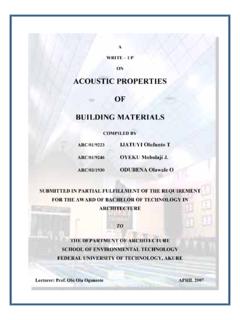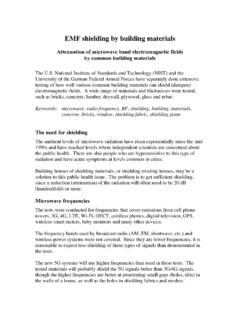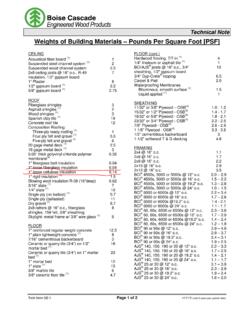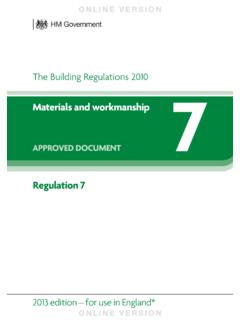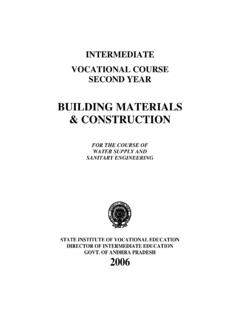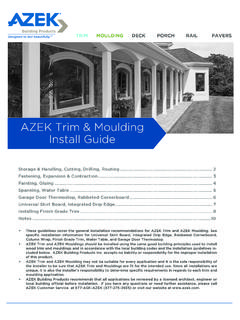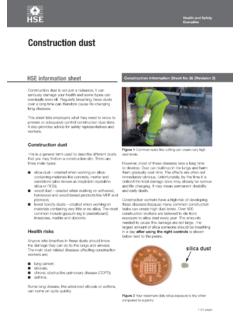Transcription of Building Deconstruction: Reuse and Recycling of Building ...
1 Building Deconstruction: Reuse and Recycling of Building MaterialsAlachua County Solid Wastes Management Innovative Recycling Project ProgramPrepared by:Bradley Guy, Interim Director, Center for Construction and EnvironmentPO Box 115703, Gainesville, Florida USA 32611-5703, Tel: (352)-392-7502 ABSTRACTThe CCE deconstructed six (6) houses during 1999-2000 to examine the cost-effectiveness of deconstruction and salvage when compared to traditional research was funded through the Florida Department of Environmental Protection(FDEP) Innovative Recycling Projects grant program. The one and two-story houses thatwere deconstructed represent typical Southeastern US wood-framed residentialconstruction from 1900 to 1950. Regulatory issues include the costs and implementationof environmental, demolition, and historic permitting practices in the Gainesville /Alachua County, Florida region, and handling of lead-based paint (LBP) materials, andasbestos containing materials (ACM).
2 Worker safety issues and technical issues includeprotection from environmental and site hazards. The salvage issues include a case-by-case materials management process for each Building . Reuse and materials redistributionscenarios include on-site and off-site redistribution and associated costs and 500 pieces of salvaged lumber were visually graded by the Southern PineInspection Bureau, to understand the effects of use and the deconstruction process mighthave on salvaged lumber for use in structural : deconstruction, selective dismantling, C&D wastes management, Building salvage, Building materials BackgroundFrom August, 1999 to May, 2000 the Center for Construction and Environment,University of Florida, with funding from Alachua County Public Works Division and theFlorida Department of Environmental Protection (FDEP) deconstructed six (6) wood-framed residential structures in Gainesville, Florida.
3 University students provided a laborforce on the first three buildings and Americorps*NCCC members worked on the secondthree. Of note is how much more efficient a trained team of workers is than workers whoare being trained. No particular worker, other than CCE staff, worked on more than twobuildings. Houses were acquired mainly through word of mouth. Four houses were indisuse and did not have time constraints for the removal, and two were being removed aspart of a redevelopment. Permitting processes included issues of historic preservation,demolition delay requirements, licensed contractor requirements and environmental,safety and health certifications for hazardous materials management, utilitydisconnections, and septic tank removals. Each house was tested for lead-based paint(LBP) and asbestos containing material (ACM).
4 All structures were completely removedfrom the site, comparable to a total demolition. Time and activity data was collected foreach worker and all associated costs and estimated revenues from salvaged materialswere calculated. Each Building was also estimated for demolition in order to make acomparison with deconstruction and salvage. There was considerable variety in thebuildings conditions, the location of the buildings, and the efficiency of SummaryThe structures ranged from approximately 1000 to 2000 SF and were both single andtwo-story. The oldest structure was built approximately 1900 and the youngest built in1950. All of the structures had at least one addition and most had two or three majoralterations or additions. The typical construction was a raised wood floor structure onbrick and/or concrete piers, light wood wall framing, roof rafters, and interior andexterior wood cladding and sheathing.
5 Two structures had plaster and lathe interior wallfinishes. In one case gypsum wall board was applied directly over the wood beadboardinterior wall finish. One structure also had two roof finishes, metal over asphalt shingles,and two floor finishes, an oak floor laid directly on top of a pine floor. Three (3) of thestructures required the removal of asbestos floor tile, and one required the removal ofasbestos gypsum wall board, roofing materials and duct insulation material. Lead-basedpaint was found in all structures. All of the structures had rot from water damageprincipally in kitchen or bath floor areas, but also including wall areas at leaks from of BuildingsBuilding address #29307111428129013650 Built19151945190019001920 s1950 Stories122111 Light framed wood / CMUYYYYYSize (SF)
6 2,0141,4362,0591,2389921,118 Urban or rural-sized parcelRuralUrbanUrbanRuralRuralRuralAddi tionsYYYYYY# of additions311231 Internal renovationsYNYNYNI nhabitableYNYNYYR equire major repairNYNYNNA sbestosExterior wall finishYNNNNNR oofingNNYNNNI nsulationNNYNNNF loor tileYNYNNYD rywallNNYNNNA batementYNYNNYLead-based paintInterior trimNNYYNNE xterior trimYYNYNYI nterior surfacesNYNNYNE xterior surfacesNYYNYYR eason for removalRedevelopment siteYYYYT axes / expenseYSafety / disuseYHomeless / fire hazardYTable One Building SummaryAll of the structures had additions, and these were typically for; 1) adding enclosed livingspace, 2) adding kitchen and bathroom facilities on older structures, 3) enclosing anexisting open porch area. Four (4) out of six (6) could be made inhabitable, three (3) ofsix (6) had been recently occupied prior to the Building s removal.
7 One (1) house hadbeen occupied by homeless persons without heat, kitchen, or bathroom facilities. Three(3) of the six (6) structures were found to have asbestos containing materials (ACM)requiring abatement. Two (2) of the structures contained only non-friable asbestos whichcould have been wet demolished by mechanical means but would have required theentire demolition wastes load to be disposed off in an asbestos certified landfill. Onebuilding had LBP only on the inside, typically LBP was found on exterior window anddoor trim, where it was used in gloss and semi-gloss paint for were a variety of reasons for the owners desire to remove the structure, but two(2) of the (6) six were on property slated for immediate commercial or multi-familyredevelopment, two (2) were on property slated for long-term redevelopment, and two (2)buildings were on land not slated for redevelopment.
8 The latter two (2) structures mayhave been left vacant for an indeterminate length of time if they had not been used forthis project. During the course of the project, one Building verbally committed to thedeconstruction project, on a site slated for commercial redevelopment, was addition, two candidate buildings, on sites slated for redevelopment, were moved. Onestructure that was considered for the project was considered too dilapidated for areasonable deconstruction and another was passed over due to scheduling conflicts andwas subsequently partially renovated by the owner. The average size for the principalstructures was 1,476 upon literature review and anecdotal information, this sample of structures wouldappear to be representative of residential demolitions in the United States.
9 Approximately94% of all residential buildings built each year in the US are light wood-framedconstruction (NAHB, 1994).Data CollectionOn-site labor was documented by recording each worker s activities on a 15-minutetime increment. There have been several well-documented deconstruction pilot projectsin the US with this detail of data collection, most notably the Fort Ord PilotDeconstruction project conducted by the Fort Ord Reuse Authority (Cook, 1997) and theRiverdale Pilot Deconstruction Project conducted by the National Association of HomeBuilders Research Center (NAHBRC, 1997). These projects provided models forcreating the data collection process. Based upon these studies and personal experience,the CCE has refined its data collection techniques over time.
10 Data is divided into twocategories; the deconstruction of the structure and the processing of the salvaged. Thedeconstruction labor data is sub-categorized according to the location in the Building , andthe specific material. The cost of a traditional demolition was calculated for eachstructure, including disposal costs. Salvage revenues were estimated using a percentage(%) of retail price from local Building materials suppliers and the experience of a formerused Building materials store owner/operator in Gainesville, Florida. Disposal costs wereestimated by weight and costs data provided by the wastes haulers for the activities were divided into categories of activities, the location or component ofthe Building and the materials that were handle.
